Category Archives for Blogs

What You Need to Know About Interior Design Apps
When you’re thinking about giving your home a fresh look, you might be considering relying on apps for convenience. Interior design apps are easy to find, but will they provide you with the right kind of help for the changes you want to make? Keep the following information about these apps in mind to help you determine if you should use them for your planned project.
Interior Design Apps
Whether you’re trying to choose new paint colors or rearranging rooms, you can find apps that make these tasks easier. Some of the more notable interior design apps include the following:
- Chairish: Browse for pre-owned, high-end decor.
- Hutch: Shop for furniture while being able to virtually outfit your room.
- Color Capture: Keep track of colors that catch your eye while you’re out and about, so you can incorporate them into your decor.
- BrightNest: Easily keep track of your decorating to-do list.
- Ikea Room Planner: Augmented reality app to see how Ikea items will look in your home.
- Morpholio Board Pro: Keep decor shopping lists, sketches, and other items handy all in one place for easy reference.
- Photo Measures: Take a quick pic of furniture, and write its measurements down to easily refer to while shopping.
While these apps can be useful, it’s important to note that they’re geared toward interior decorating rather than interior design. These projects might sound similar, but there are notable differences between them.
Interior Decorating vs. Design
Whether or not you should use these apps depends on the kinds of changes you’re thinking of making to your home. If you’re interested in updating your wallpaper, getting new furniture, or choosing new art or accessories, these apps might be right for you. However, they really should be considered interior decorating apps rather than interior design apps. Interior decorating involves making aesthetic changes to a room without replacing or installing new fixtures.
Interior design refers to making changes to permanent fixtures like appliances, lighting, or windows for a kitchen remodel. These projects can involve input and expertise from professional interior designers and architects, such as ensuring that paint colors complement your new fixtures. These projects are typically much more complex than interior decor projects.
Whether you’re planning on making some smaller changes or completely remodeling your bathroom or another part of your home, hiring professional interior designers can help you achieve the results you want. With interior decorating projects, you don’t necessarily need to hire professionals. Depending on the scope of your project, you might be able to depend on interior decorating or design apps to help you do your planning. However, having interior decorating experts assist you might help this process go more smoothly.
If you need interior design services for your home in the San Francisco Bay area, contact Drafting Cafe Architects. We’ll provide you with a free estimate and help you choose the best fixtures for your home. Keep in mind that we also provide interior decorating services to help you improve the look of your home.
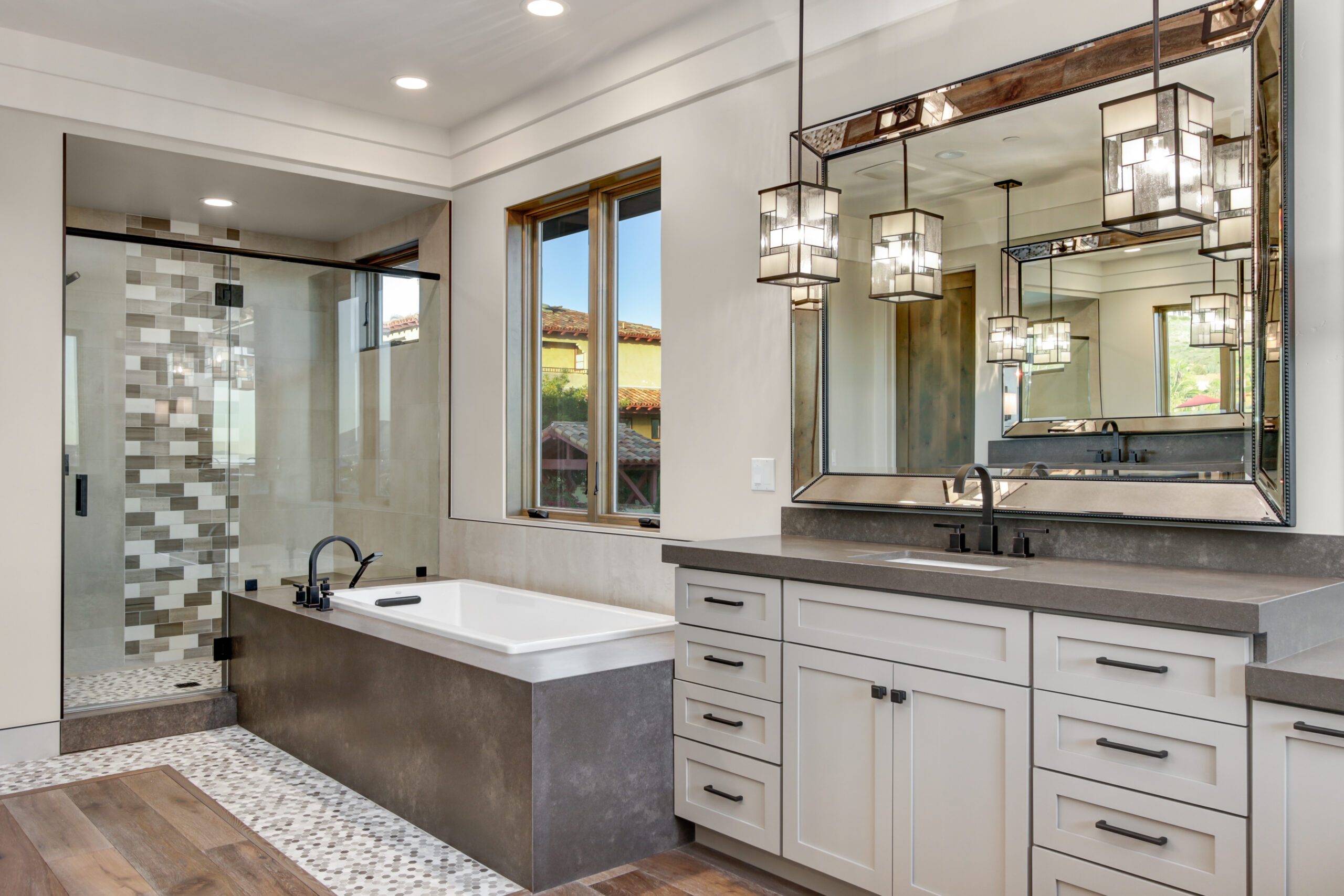
Bathroom Remodel Ideas – Now That We’ve Been Staying Home Together
With the ongoing COVID-19 pandemic, your bathrooms are probably getting much more use than usual with everyone home all the time. This situation might have you thinking about a bathroom remodel that is more functional rather than trendy. Consider the following ideas if you’re looking for ways to improve the bathrooms in your home.
Wear and Tear Prevention
With you and your family using your bathrooms more often, it’s important to make sure they can hold up well to daily wear and tear. This might mean having older or less durable fixtures, such as cabinets made of particleboard, replaced with materials that will last longer. Having durable cabinets and other fixtures means you won’t need to replace them sooner than expected, have them refinished or repaired.
When you’re considering bathroom remodel options, you should also plan for maintenance. Surfaces in your bathrooms should be as easy to clean as possible. Fixtures that have a lot of detailed surfaces, such as heavily carved designs on cabinet doors, easily collect grime and dirt. These kinds of surfaces are also harder to clean overall. Choose smoother bathroom surfaces for easier maintenance.
Usage Improvements
The current situation offers a great opportunity to stress-test how you and your family are using the bathrooms in your home. You might notice that your bathrooms are ending up messier than before due to being too small for all of that extra use. You might discover that you could use another bathroom, even if it’s just a half-bathroom, to help cut down on messes while also ensuring that everyone is able to use these rooms as often as needed.
Depending on your current setup, you might need to look into adding space to at least one of your bathrooms. If you only have one bathroom or too few bathrooms overall, you might explore your options for having one added.
Improved Efficiency and Safety
Being at home all the time now might have you thinking about ways to improve bathroom safety and efficiency. For example, most building codes require GFI safety outlets installed if your home is older in order to reduce the risk of electrical shocks. If your bathrooms don’t have fans, you need these installed for improved ventilation.
You might be dealing with higher water bills with everyone being home. To bring these bills down and improve bathroom efficiency, you might look into having energy-efficient fixtures installed, such as low-flow toilets, sinks, and shower heads. These changes can significantly reduce your water usage, even with everyone home.
If you’re exploring bathroom architecture options, please contact Drafting Cafe Architects for a free estimate. Our team of experienced architects and designers helps Bay Area homeowners make improvements to their homes. We look forward to combining your input with our expertise to help you with your bathroom remodel.
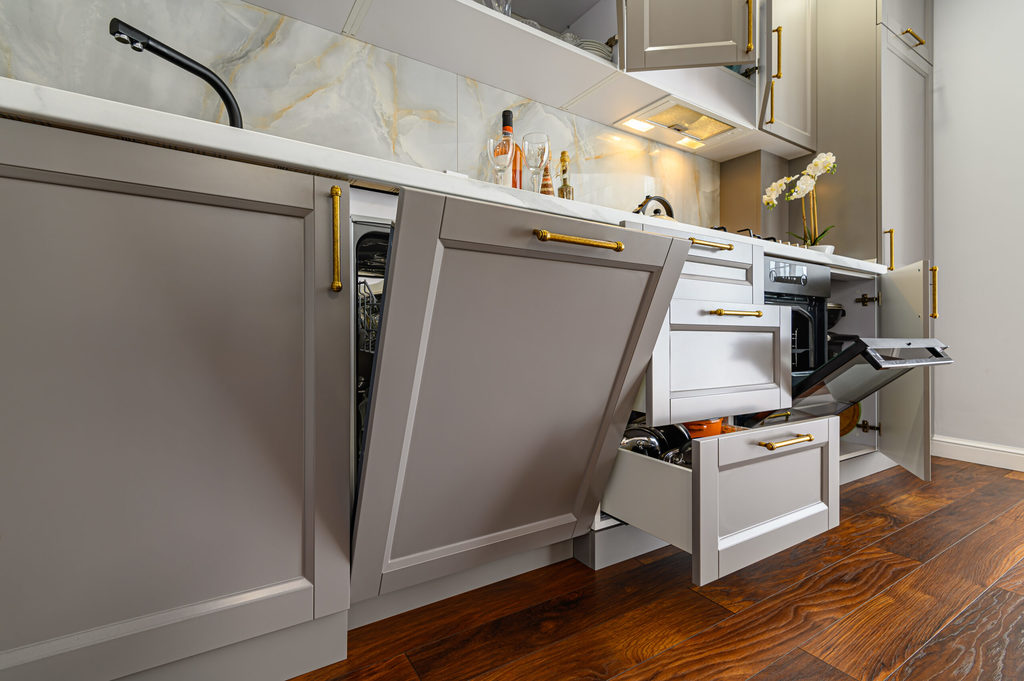
Kitchen Remodel Ideas – Now That We’ve Been Staying Home Together
Before the COVID-19 pandemic, kitchen remodel projects typically revolved around incorporating the latest trends for an updated look. However, now that many of us in the Bay Area have been living and working at home around the clock, you might have noticed that the latest trends aren’t necessarily giving you the best home environment. When you’re juggling working from home while also supervising your children’s remote learning, making changes to your kitchen can help things go more smoothly. Keep the following in mind when you’re thinking about improving your kitchen.
Wear and Tear
When you and your family are in your kitchen more often, wear and tear shows. Your kitchen needs to have fixtures that can handle heavier use, as well as surfaces that are easy to clean and maintain. For example, debris and grime can accumulate on surfaces with ornate details, such as cabinets and hardware. Appliance trends that were popular with chefs can be difficult to clean. For example, a gas cooktop with multiple burners versus an electric cooktop with a single glass surface. Sometimes the sacrifice is worth it and in some cities, new construction will not allow gas appliances for safety reasons.
Daily Use
Your daily kitchen usage before the pandemic was probably limited to breakfast and dinner, along with a few general tasks, such as going through mail or helping kids with their homework. During the pandemic, though, your kitchen usage has most likely increased significantly. While working from home and kids in remote school, you’re now using your kitchen for all three meals, as well as snacks, throughout the day. Cleaning, homework, and other regular tasks might also be done more often these days, which adds to your kitchen traffic.
Your family’s needs should be a priority when it comes to remodeling your kitchen. The latest trends might not offer the convenience or the right setup to handle your family’s increased kitchen use. Architects can help you make the best changes that allow you and your family to use your kitchen more comfortably.
Efficiency
Being home all the time means you’re probably experiencing higher energy bills from the lights being on more or the stove and other appliances being used more often. When you’re planning to remodel your kitchen, keep efficiency in mind. There are several changes you can make in order to improve your energy efficiency and avoid huge energy bills. For example, you might replace your dishwasher with a newer dish drawer model, so you can do smaller loads. You might also want to consider other kitchen remodeling changes, such as having a smaller convection oven installed for more efficient cooking. Improving the ventilation in your kitchen will help from smelling last night’s dinner during your morning meetings.
At Drafting Cafe Architects, our team focuses on helping clients in the Bay Area achieve results that work best for their life rather than relying on trends. We work with clients on coming up with kitchen architecture designs that help them get the most out of their home, which involves taking each client’s’ input into consideration. Please contact us today for a free estimate on your kitchen remodel.
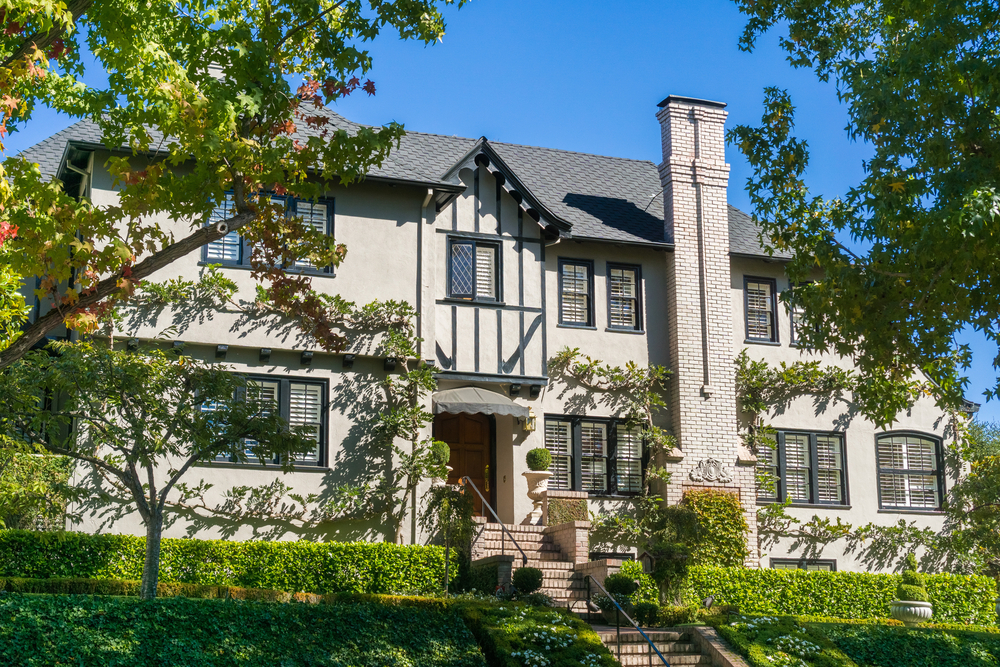
Avoiding Architectural Design Fail: How To Match Remodeling Styles
Remodeling your home gives you a chance to give it an updated look and enhance its visual appeal. In order to achieve this effect, it’s important to make sure the exterior and interior of your home have the same flow. Remodeling the interior of your home in a way that doesn’t match or flow with its exterior architectural style can create the wrong effect. When the exterior and interior styles of your home clash it has an impact on the way your home looks and feels overall – especially to visitors. Keep these tips on remodeling in mind while considering your home’s architectural style.
Interior vs. Exterior
When planning your home remodel, think about what it will be like to walk into your home after experiencing the exterior look. When you have a certain architectural style on the outside, you’ll want a complimentary interior remodel so it doesn’t seem as though you’re in a completely different home. For example, if your home has a Victorian or Craftsman architectural style on the outside, you should avoid making changes that give it a contemporary look on the inside.
When you remodel a home with an older architectural exterior style, you should preserve that style inside. You can make major changes to the interior as needed, but keep your home’s overall architectural style in mind. For example, you can add built-in bookcases, stained glass accents, or more wood framing to your interior remodel to maintain a Craftsman-style exterior.
If your home’s architectural style is more contemporary, you should avoid making remodeling changes that take the interior back in time. This can create a jarring effect when walking into your home from the outside. Contemporary homes often have a more open floor plan with a lot of natural lighting. Making changes to the layout, such as adding walls or doors for more privacy, can make your home interior feel more dated compared to the exterior.
Work with an Architect
Trying to decide on changes to make that fit with your home’s architectural style can be difficult. Hiring an architect is an effective way to make sure you end up with a home interior that flows well with and fits the exterior. Architects have the knowledge needed to recommend certain changes as part of your remodel. These changes can ensure that your home has a cohesive look and feel.
When you work with an architect for your home remodeling project, you can also easily narrow down your options. An architect can direct you to options that fit your home’s architectural style, so you can zero in on these instead of considering options that might not work well. This can make the remodeling planning phase go more smoothly and help you save time.
If you’re planning to remodel your San Francisco Bay Area home, please contact Drafting Cafe Architects today to get a free estimate. Our architects can help you create the right changes to your home in order to maintain a harmonious flow between the exterior and interior.

Plan an Affordable Bathroom Remodel
The best bathrooms are a place of comfort, luxury, and beauty. Older bathrooms sometimes fall short of this mark. Many older bathrooms lack modern features that can increase comfort, functionality and value. Remodeling your bathroom is a fantastic way to improve your quality of life at home and increase your home’s value at the same time.
Before the remodel can begin, it’s important to know the cost and make a budget that helps put some boundaries around your remodeling plan. Ultimately, the cost of your upcoming remodel will depend on many factors, including the scope of the project, quality of materials, cost of labor, and other your desired styles.
What Factors Affect Bathroom Remodel Cost?
Generally speaking, bathroom remodels usually fall into two categories: midrange and upscale. Midrange remodels are relatively modest, with a focus on high-value, low-cost changes. Upscale remodels often involve large-scale changes and/or the purchase of high-end fixtures.
What’s Included in a Midrange Remodel?
Midrange remodels involve the replacement of all fixtures, but not a relocation of the fixtures in the bathroom. No walls are moved for this kind of remodel, but at the end, the space is still transformed with new tiles and shower surround, new shower fixtures and toilet, a new vanity and sink. Midrange remodels can be especially beneficial if you’re selling your home sometime in the next five years, because the relatively modest cost translates to high ROI.
What’s Included in an Upscale Remodel?
Upscale remodels change the space entirely. Often, this includes expansion and changing the configuration. All new fixtures add functionality, while high-end features like a freestanding soaker tub create a spa-like environment, perfect for relaxing.
Upscale bathrooms are large enough for his and her sinks and medicine cabinets, an extra-large vanity for storage, and an in-floor heating element for added comfort before and after showers. The expanded size usually requires more ventilation and electrical updates. Thus, your plan will need to be reviewed and bid by multiple contractors – always a smart idea, anyway.
What Else Impacts Bay Area Bathroom Remodel Cost?
Good quality materials can increase costs. However, it’s a mistake to buy low-quality materials just to save money. Poor quality fixture break quickly, need repairs often, and can lead to leaks that cause structural damage. It’s important to purchase the highest quality you can afford when it comes to fixtures.
Midrange Vs. Upscale Bathroom Remodel Costs
Typically, modest costs translate to higher ROI. If you’re concerned about controlling costs while also getting the best value for your money, work with the architectural designer to maximize your return for your bathroom remodel. They can help guide you up front.
Bathroom Remodel (Midrange) Job Cost: $28,800 (89% ROI)
Bathroom Remodel (Upscale) Job Cost: $86,300 (72% ROI)
Work With Experts
Is you are planning to remodel your Bay area bathroom, Drafting Cafe can help you plan and design. They offer interior design support and design-to-build for the homeowner that’s too busy for project management. Call today to make make an appointment and start your consultation.
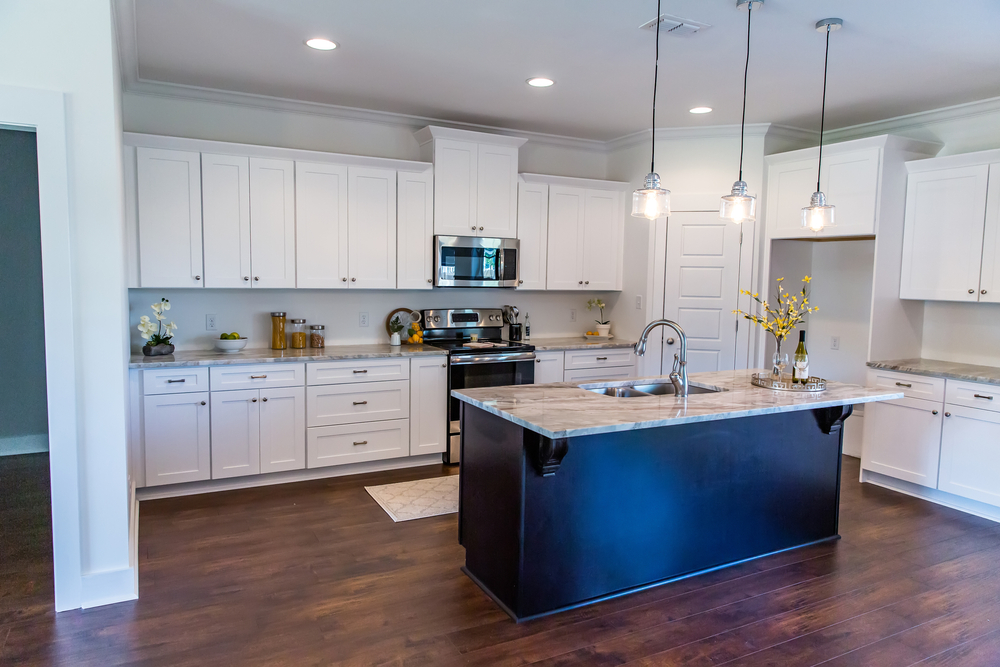
Compare Kitchen Remodeling Costs For Your Project
Budgeting is an important part of remodeling your kitchen in the Bay Area. Knowing how much your kitchen remodel will cost and what can be done to help increase ROI, if that is a priority for you, is an important part of your initial planning. Even if money is not a major concern, knowing how much you can expect your remodel to cost will help keep costs from getting way out of line. It’s easy to do if you are dreaming and not realistic.
What Factors Affect Kitchen Remodel Cost?
Kitchen remodels are all unique, depending on what’s being remodeled or replaced and whether the focus is on high-end installation and replacement or mid-range reuse, recycle. Changes being made, cost of materials, contractor costs and condition of the property are all factors that can make a big difference.
What’s Included in a Minor Remodel?
When a contractor or designer talks about a minor kitchen remodel, below are the kind of changes you can expect them to make:
• Keep the cabinet boxes, but replace the cabinet doors and drawer fronts
• Replace countertops
• Install new flooring
• Replace cooktop/oven and refrigerator
• Replace sink and faucet
• Paint walls, ceiling and trim
The materials used may be quality, but not top-of-the line. Cost-saving measures like a replacement of the doors and drawers (keeping cabinet boxes) help make this type of remodel affordable for households on a budget.
What’s Included in a Major Remodel?
When a contractor or designer talks about a major kitchen remodel, below are the kind of changes you can expect them to make:
- Change the layout – moving walls – to improve functionality
- Install new backsplash
- Replace appliances, some may be built-in
- Install new cabinets (semi-custom or custom)
- Installation of custom lighting including task lighting and undermount
- Replace countertops
- Installation of or replacement of kitchen island
- Replace sink, faucets and water filtration system
Depending on whether the remodel is midrange or upscale, features may be designer, top-of-the line, or mid to high-end. Imported materials and custom features can dramatically increase costs for a remodel of this type.
What Else Impacts Kitchen Remodel Cost in the Bay Area?
Some remodels just cost a lot more than others. Changes that can dramatically increase costs include:
- Changing the floor plan
- Increasing the size
- Adding on to the house, changing the foundation
- Updating infrastructure – older homes
Want to reduce your utility costs with new, updated appliances? Older homes often need new dedicated circuits to be installed before a new appliance can be installed. While energy-efficient appliances can save money, they tend to cost more up front. You will need to follow current building codes which are unavoidable costs which includes permitting costs.
Minor Vs. Major Kitchen Remodel Costs
If you’re concerned about ROI, the best value usually comes from minor, mid-range kitchen remodels. With this type of remodel, you can recover almost 100% of your costs when you sell. Major remodels have lower ROI because the up front costs are so much greater.
Minor Kitchen Remodel (Midrange) Job Cost: $30,500 (94% ROI)
Major Kitchen Remodel (Midrange) Job Cost: $83,400 (73% ROI)
Major Kitchen Remodel (Upscale) Job Cost: $163,700 (70% ROI)
Plan An Affordable Remodel
Are you remodeling your Bay Area kitchen? Drafting Cafe has years of local experience to help you with whatever range of kitchen remodel you need. We offer simple architectural design and complete design-to-build services helping all the way through construction. Call today to discuss your project.
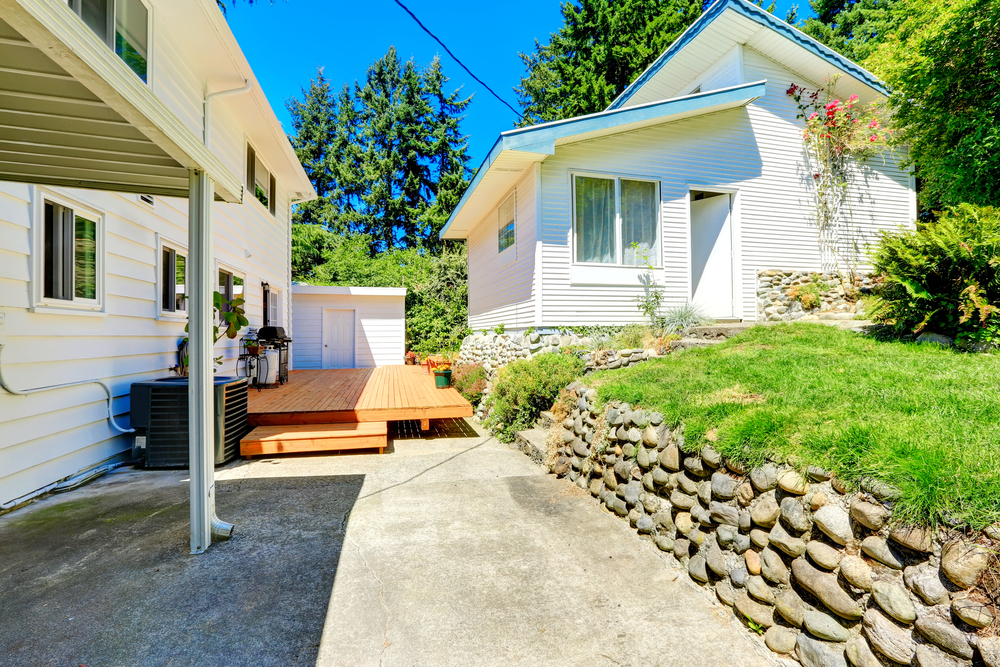
How to Invest In a Bay Area Backyard Home
You may have heard that cities are relaxing restrictions for adding backyard homes. Maybe it’s time to build one on your own property. But, do the benefits of an ADU outweigh the investment? Can you make money from an in-law unit? Knowing the answers to these questions can help you decide for sure whether this type of home improvement is right for your situation, and if so, what goals to set for your ADU construction. Here’s what you need to know.
Benefits of a Bay Area Backyard Home
Backyard homes are multi-purpose fixtures that can improve the value of your property, make your home easier to sell, and provide a continuous source of income. A well-designed backyard home can also become a safe, affordable living space for other members of your family, whether that’s a senior relative hoping to live with you or an adult child who needs someplace to live after college graduation.
More benefits:
- A typical rental ADU can pay for itself in about 10 years, and after it’s paid off, profits set in.
- Installation is relatively fast! It takes about a year to build an ADU, from the first planning of the project to the final stages of construction.
- ADUs are flexible in their application – what is a rental unit today can become a home for your senior parent later.
The Financials of a Backyard Home
In the San Francisco area, a typical ADU can cost anywhere from about $50,000 to $100,000, depending on the size and features. Construction costs only make up one aspect of the financial component of building an ADU. Permits and design fees are part of the cost of an ADU.
Budget for Your Backyard Home
Budgeting for your ADU is important. Unless you’re planning to pay for your ADU with cash outright, contact lenders to get qualified and determine how much you can borrow. Other expenses to take into consideration when building an ADU include property taxes, rental operating expenses, taxes on rental income, and any limits on rental rates that might be set by your local city.
Shop around for the loan.
Most homeowners are not real estate investors and don’t have the start up capital for an ADU. If you’re getting a loan, shop around to get the lowest interest rate and best deal.
Backyard Home Profits
Do your homework locally before investing in an ADU. Some counties may put a cap on the rent for your ADU, which can affect your profits. If you are a number’s person, you can create a spreadsheet that will help project how long you’ll take to pay off a backyard home given the maximum amount you can charge in rent. Depending on your location, you might make more renting to vacationers or short-term rentals where you may be able to charge more.
Design Your Ideal Backyard Home
Design and style are a huge consideration for an occupant. If you planning for ROI, having a current design style with an open floorplan and storage consideration will keep your tenants happy. The longer you can keep your unit rented the less expense you will incur, unless it’s a bad tenant.
ADU styles mimic home styles. Today, spacious plans with high ceilings are common. There are many ways to design your ideal backyard home. The easiest is to start with a plan and make a few architectural design changes to fit your lot and needs.
Starting the Backyard Home Process
Are you ready to start your ADU construction project? Drafting Cafe has a few turn-key plans that can make your build a breeze. And if you one of those homeowners who just wants it done and doesn’t want to be bothered with every little detail, check out our design-to-build backyard home design service. Make an appointment and our professional project managers will be in touch.
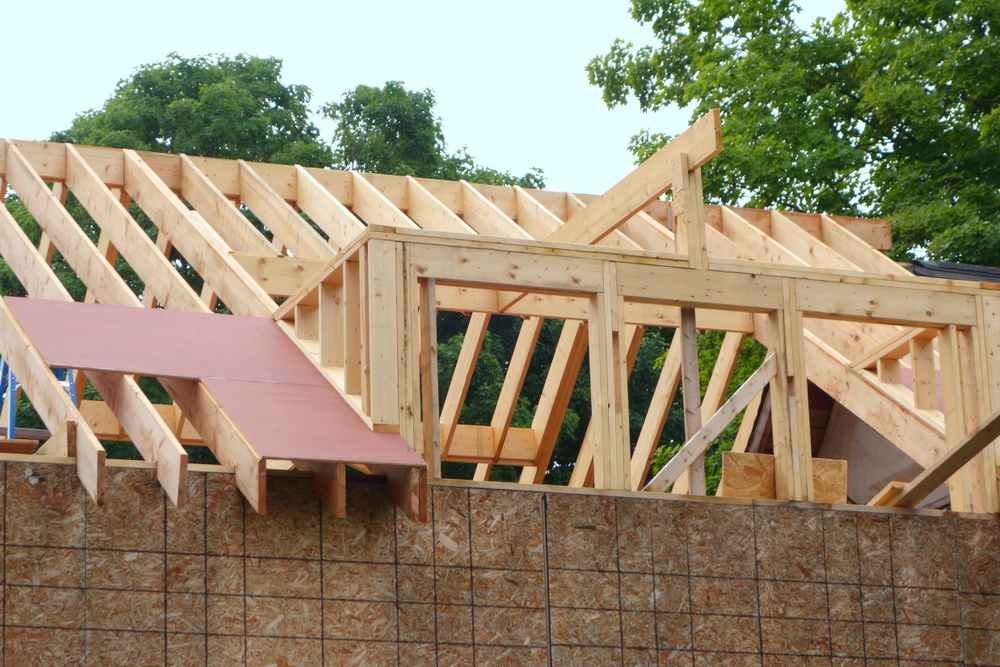
What You Need to Know Before a Home Addition
After all this togetherness, adding space is probably a top priority for your home remodeling project. When your remodeling project becomes a home addition, you need to plan for a lot more considerations and rules than a simple update would entail.
Additions vs. Remodel
The big factor is when you expand the footprint of your existing home. As soon as you change anything that expands outward or upward, more people get to have an opinion on what you do. Even below grade excavations will require significant approvals from your city and/or county. Most of these are for your own protection and safety.
If your neighborhood’s homes are mostly single story, you could learn there are height restrictions. Another common restriction in California is a limitation on lot coverage – commonly known as set-backs. This is how far your house needs to be from the lot line and what percentage of the lot living structures are allowed to occupy. This become a big problem in the San Jose area when many tech workers were buying homes only to demolish and rebuild mansions on the small lot.
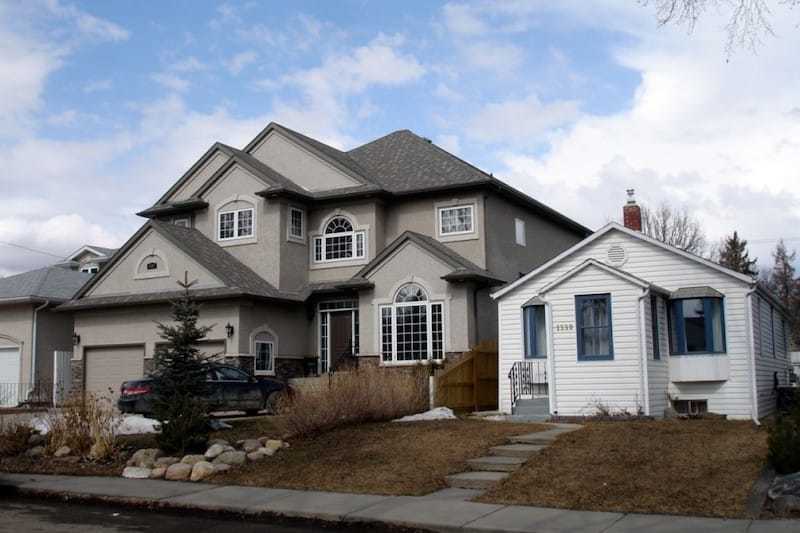
Neighbors and homeowner associations often have additional requirements, including the right to review and approve plans prior to construction. They may have ordinances that govern architectural style, window placement, or paint color. You may be subject to opinions that seem personal and punitive rather than safety focused. “Design Review” committee horror stories are worth looking into. Review the rules BEFORE starting your design plan. You don’t need to pay for design revisions that you could have known about with a single call to your association president – hopefully not Cynthia.

Owners of homes in designated historic districts face more stringent requirements. Maintaining historic design while bringing these older homes into compliance with current building codes or energy and safety standards can be costly. Even a small remodel can trigger the need for major infrastructure updates like electrical and plumbing.
When planning an ADU – accessory dwelling unit – you will fall into another category of additions. Fortunately, more cities are relaxing their rules on ADUs to encourage affordable, higher density housing.
Any update that adds square footage will most likely trigger a tax reassessment when the project is completed. This will also change the replacement value of your home and is worth a call to your insurance company. The good news is your home will be worth more when you go to sell.
Permits
Some renovations, including updates to existing bathrooms and kitchens may only require what is known as an “over-the-counter” permit and payment of the required fee. But chances are that if you plan an extensive remodel or expand with an addition, you will need to submit a complete set of architectural plans for review by your city/country Building Inspection Department prior to issuance of the required permit.
Minimize Your Stress
There are a lot of decisions and hoops to jump through before you finish your dream home addition. Having a team of professionals who know your area, work well with the local authorities, and understand your goals will keep your project moving forward. There are always glitches, but with careful planning you can be prepared for them and minimize costly changes.
Finding an architect who can advise you on these potential hurdles based on your goals is a critical step. If an architect is only designing for their portfolio (many do) they may create a design that will end up costing you time, money, and headaches. Drafting Cafe Architects focuses on your goals and will advise you based on their experience in your area. We have worked with almost every permit office in the Bay Area at one time or another and have extensive home addition experience. Contact us today for a free consultation about your plan.

Pandemic Pitfalls for Your Home Remodel – What You Need to Know
Preparation is an important part of a successful remodel. If you’ve remodeled your home before, you already know some of what this entails. Listing your remodeling goals, making a budget, scanning through magazines for ideas, working with a successful design firm to create a plan – these are all normal steps in the path to creating a home remodeling plan.
However, like so many things, the steps to remodeling have changed a little since the start of the pandemic. Knowing what to expect and how to prepare can help you as you get started.
Interview Many Contractors
It was important before the start of the pandemic to interview several contractors before hiring the right one for you. That’s even more important today because the best home remodeling and design build contractors are booked out months in advance. Plan to start interviewing contractors well ahead of time, especially if you have a firm remodeling deadline. Cast a wide net, and expect to wait after hiring.
Expect COVID Cleaning Fees
Many contractors provide COVID cleaning services during the project or after, especially if your project takes place indoors and in your house. Expect to see COVID cleaning fees on your itemized bid. If you don’t, ask your contractor about their plan for keeping your space safe and sanitized. Be wary of contractors who don’t have a definite answer to these questions – at this point, every home remodeling contractor should have a satisfactory plan in place.
Get Ready Early
While the best contractors are now booked out for months in advance, plans can change if there’s a sudden cancellation. Work with your design build service to get your drawings ready as early as possible, so you can take any time slots that open up unexpectedly. The design process usually involves a consultation at the beginning, and then a few follow up conversations as sketches start to come in. Staying on top of this process can help ensure you’ll be fully prepared if your contractor comes available.
New international tariffs and COVID shutdowns have made material backorders common. Choose your materials as soon as possible and order them quickly to avoid delays.
Hold Your Place With a Deposit
While some contractors saw a dip in demand for services when the pandemic began, others saw demand for their services increase. The market has also become more volatile since the start of the pandemic, with some homeowners canceling their remodels suddenly after waiting for weeks.
Your contractor may ask you to put down a deposit to hold your place in line, even if it’s far in advance. Before putting your money down, sign a contract that outlines your contractor’s cancellation policies. Read the contract thoroughly and only sign when you feel comfortable.
Hire a Project Management Team
What’s the best way to kick off a home remodeling project? Hire a project management team like Drafting Cafe Architects design-to-build service. We provide interior design, ADU plans and full service design-to build remodeling management, providing everything from drawings to plans, permitting and construction support throughout the entire building process. Call Drafting Cafe Architects to get started today.

Must Have Luxurious Trends For Your Bathroom Remodeling Project
Making upgrades to your bathroom from time to time is a great way to boost your home’s value while also ensuring that you have a stylish and comfortable place to get ready for the day. Consider using a few of the latest trends for your bathroom remodel.
Wet Rooms
Wet rooms feature a completely waterproof design that provides you with more interior design options. For example, you can use stone or concrete materials in this type of bathroom to give it a more rustic or upscale appearance. A wet room can also help you save on space, since you can have a shower with a small or partial enclosure installed rather than bulky doors.
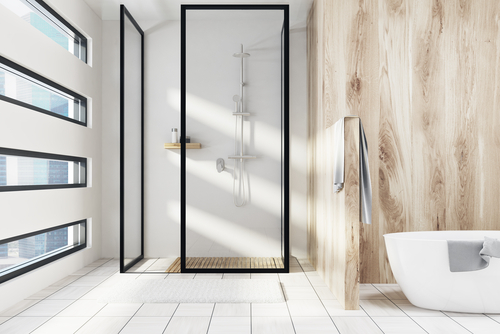
Toilet with a Built-in Bidet
Having a bidet provides you with a more convenient way to keep clean. This is one of the latest bathroom trends is luxury toilets featuring a built-in bidet. When choosing one of these for your bathroom, keep in mind that some offer special features, such as heating the toilet seat or playing music – yes, really! Your architectural designer will need to know about this feature as this requires an electrical outlet on the wall below your toilet which is not a common electrical element.
Countertops
When you’re comparing bathroom countertop material options, consider choosing marble. This material is among the more recent trends for bathroom remodels. Marble countertops provide bathrooms with a touch of elegance and a timeless appeal while also giving you a durable surface that isn’t vulnerable to cracks and heat damage.

Cabinets and Vanities
Cabinets and vanities with a floating design are among the latest styles for bathrooms. These designs can give bathrooms a more spacious appearance while also providing plenty of storage space. Floating cabinets and vanities hang off the wall rather than reaching the floor, which opens up space underneath.
Tile Styles
The latest bathroom tile styles feature tiles in a wide range of visually appealing shapes, such as arabesque, chevron, and hexagon shapes. These styles can be used to adorn bathroom backsplashes, wall and ceiling accents, and shower walls. Tile can add a lux designer touch to any bathroom, especially when you work with an experienced interior design professional to tie it into your complete design.
Tubs
Recent bathtub trends favor freestanding tubs with a deeper design, which offers a more comfortable and luxurious soaking environment. Japanese soaking tubs are among the designs in demand, especially for those with smaller bathrooms. These rounded tubs take up less space than traditional tubs.
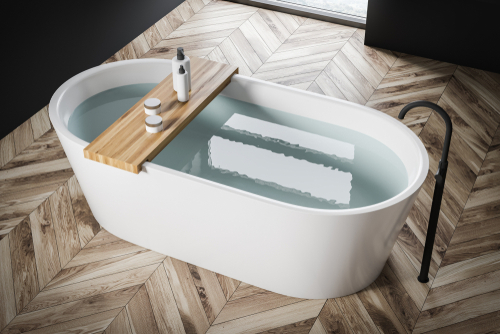
Floors
What kind of flooring material should you choose for your bathroom? Recent trends for bathrooms include wood planks and travertine. Wood planks provide an organic look and feel to bathrooms, while travertine adds a warm look. Options can include tile that looks like wood, but in fact is non-slip and easy to clean.
Body Sprays
Body sprays provide a feeling of being in a gentle rain shower. These sprays also help create a spa-like environment in bathrooms for added luxury and comfort. Multi-body sprays that spray water horizontally are among the options to consider if you want to add this feature to your bathroom. Again, your designer needs to know this plan in advance so they can add all the plumbing elements for your contractor. Adding this later may cost time and money.
If you’re planning a bathroom remodel thinking about all the design trends you want in advance is important. That’s why working with a firm like Drafting Cafe Architects is so easy. We counsel you on these possibilities and have an interior designer on staff to help you plan ahead for materials and features. Contact us for a Free Estimate and learn more about our services. We can assist you in using the latest bathroom trends for your remodel and create the ideal look and environment for your bathroom oasis.
